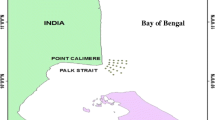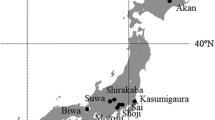Abstract
We addressed potential sources of error in estimating the water clarity of mountain lakes by investigating the use of beam transmissometer measurements to estimate Secchi disk depth. The optical properties Secchi disk depth (SD) and beam transmissometer attenuation (BA) were measured in Crater Lake (Crater Lake National Park, Oregon, USA) at a designated sampling station near the maximum depth of the lake. A standard 20 cm black and white disk was used to measure SD. The transmissometer light source had a nearly monochromatic wavelength of 660 nm and a path length of 25 cm. We created a SD prediction model by regression of the inverse SD of 13 measurements recorded on days when environmental conditions were acceptable for disk deployment with BA averaged over the same depth range as the measured SD. The relationship between inverse SD and averaged BA was significant and the average 95% confidence interval for predicted SD relative to the measured SD was ±1.6 m (range = −4.6 to 5.5 m) or ±5.0%. Eleven additional sample dates tested the accuracy of the predictive model. The average 95% confidence interval for these sample dates was ±0.7 m (range = −3.5 to 3.8 m) or ±2.2%. The 1996–2000 time-series means for measured and predicted SD varied by 0.1 m, and the medians varied by 0.5 m. The time-series mean annual measured and predicted SD’s also varied little, with intra-annual differences between measured and predicted mean annual SD ranging from −2.1 to 0.1 m. The results demonstrated that this prediction model reliably estimated Secchi disk depths and can be used to significantly expand optical observations in an environment where the conditions for standardized SD deployments are limited.
Similar content being viewed by others
References
Bacon, C. R., J. V. Gardner, L. A. Mayer, M. W. Buktenica, P. Dartnell, D. W. Ramsey & J. E. Robinson, 2002. Morphology, volcanism, and mass wasting in Crater Lake, Oregon. Geological Society of America Bulletin 114: 675–692.
Baker, E. T. & J. W. Lavelle, 1984. The effect of particle size on the light attenuation coefficient of natural suspensions. Journal of Geophysical Research 89: 8197–8203.
Behrenfeld, M. J. & E. Boss, 2003. The beam attenuation to chlorophyll ratio: an optical index of phytoplankton physiology in the surface ocean? Deep Sea Research Part I: Oceanographic Research Papers 50: 1537–1549.
Binder, B. J. & M. D. DuRand, 2002. Diel cycles in surface waters of the equatorial Pacific. Deep Sea Research Part II: Topical Studies in Oceanography 49: 2601–2617.
Burns, N. M., 2001. Trends in the ecosystem structure and water quality of Crater Lake, Oregon, from 1985 to 2000. Preliminary Report prepared for the United States Geological Survey. Lake Consultancy Report 2001/1, 31 p.
Burns, N. M., J. C. Rutherford & J. S. Clayton, 1999. A monitoring and classification system for New Zealand lakes and reservoirs. Lake and Reservoir Management 15: 255–271.
Byrne, J. V., 1965. Morphology of Crater lake. Limnology and Oceanography 10: 462–465.
Canfield, D. E. & R. W. Bachmann, 1981. Prediction of total phosphorus concentrations, chlorophyll a, and Secchi depths in natural and artificial lakes. Canadian Journal of Fisheries and Aquatic Sciences 38: 414–423.
Carlson, R. E., 1977. A trophic state index for lakes. Limnology and Oceanography 22: 361–369.
Davies-Colley, R. J., W. N. Vant & D. G. Smith, 1993. Colour and Clarity of Natural Waters, science and management of optical water quality. Ellis Horwood, New York, 310 p.
Diller, J. S., 1897. Crater Lake, Oregon. National Geographic Magazine 8: 33–48.
Gallegos, C. L., 2005. Optical water quality of a blackwater river estuary: the Lower St. Johns River, Florida, USA. Estuarine, Coastal and Shelf Science 63: 57–72.
Goldman, C. R., 1988. Primary productivity, nutrients, and transparency during the early onset of eutrophication in ultra-oligotrophic Lake Tahoe, California-Nevada. Limnology and Oceanography 33: 1321–1333.
Hall I. R., S. Schmidt, I. N. McCave & J. L. Reyss, 1999. Particulate matter distribution and 234Th/238U disequilibrium along the Northern Iberian Margin: implications for particulate organic carbon export. Deep Sea Research Part I: Oceanographic Research Papers 47: 557–582.
Hintze, J. L., 1998. NCSS 2000 Statistical System for Windows. Kaysville, Utah.
Hodges, B. A. & D. L. Rudnick, 2004. Simple models of steady deep maxima in chlorophyll and biomass. Deep Sea Research Part I 51: 999–1015.
Højerslev, N. K., 1986. Visibility of the sea with special reference to the Secchi disc. SPIE Ocean Optics VIII 637: 294–305.
Larson, G. L. & M. W. Buktenica, 1998. Variability of Secchi disk readings in an exceptionally clear and deep caldera lake. Archiv fur Hydrobiologie 141: 377–388.
Larson, G. L., C. D. McIntire, C. D. Hurley & M. W. Buktenica, 1996. Temperature, water chemistry, and optical properties of Crater Lake. Lake and Reservoir Management 12: 230–247.
Morel, A., 1974. Optical properties of pure water and pure sea water. In Jerlov N. G. & E. S. Nielsen (eds), Optical Aspects of Oceanography, Academic Press, New York, 1–24.
Pegau, W. S., D. Gray & J. R. V. Zaneveld, 1997. Absorption and attenuation of visible and near-infrared light in water: dependence on temperature and salinity. Applied Optics 36: 6035–6046.
Phillips, K. N. & A. S. Van Denburg, 1968. Hydrology of Crater, East, and Davis Lakes, Oregon. U.S. Geological Survey, Water Supply Paper 1859-E.
Pilgram, D. A., 1984. The Secchi disk in principle and in use. The Hydrograph Journal 33: 25–30.
Pope, R. M. & E. S. Fry, 1997. Absorption spectrum (380–700 nm) of pure water. II. Integrating cavity measurements. Applied Optics 36: 8710–8723.
Preisendorfer, R. W., 1986. Secchi disk science: visual optics of natural waters. Limnology and Oceanography 31: 909–926.
Smith, R. C., J. E. Tyler & C. R. Goldman, 1973. Optical properties and color of Lake Tahoe and Crater Lake. Limnology and Oceanography 18: 189–199.
Spinard, R. W., C. M. Yentsch, J. Brown, Q. Dortch, E.␣Haugen, N. Revelante & L. Shapiro, 1989. The response of beam attenuation to heterotrophic growth in a natural population of plankton. Limnology and Oceanography 34: 1601–1605.
Topliss, B. J., J. R. Miller & E. P. W. Horne, 1989. Ocean optical measurements- II. Statistical analysis of data from Canadian eastern Arctic waters. Continental Shelf Research 9: 133–152.
Udy, J., M. Gall, B. Longstaff, K. Moore, C. Roelfsema, D.␣R. Spooner & S. Albert, 2005. Water quality: a combined approach to investigate gradients of change in the Great Barrier Reef, Australia. Marine Pollution Bulletin 51: 224–238.
Wetzel, R. G., 1983. Limnology. 2nd edn. Saunders College Publishing, PA, 767 p.
Author information
Authors and Affiliations
Corresponding author
Rights and permissions
About this article
Cite this article
Larson, G.L., Hoffman, R.L., Hargreaves, B.R. et al. Predicting Secchi disk depth from average beam attenuation in a deep, ultra-clear lake. Hydrobiologia 574, 141–148 (2007). https://doi.org/10.1007/s10750-006-0349-z
Issue Date:
DOI: https://doi.org/10.1007/s10750-006-0349-z




